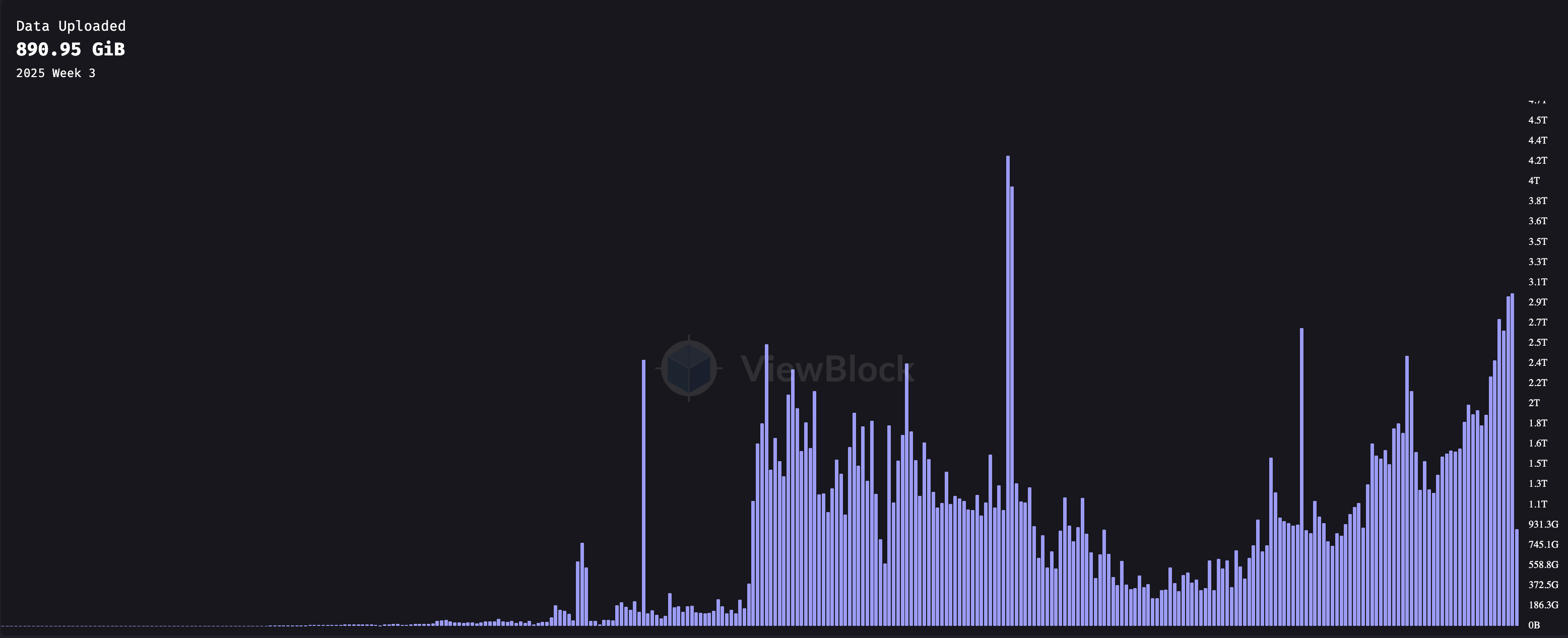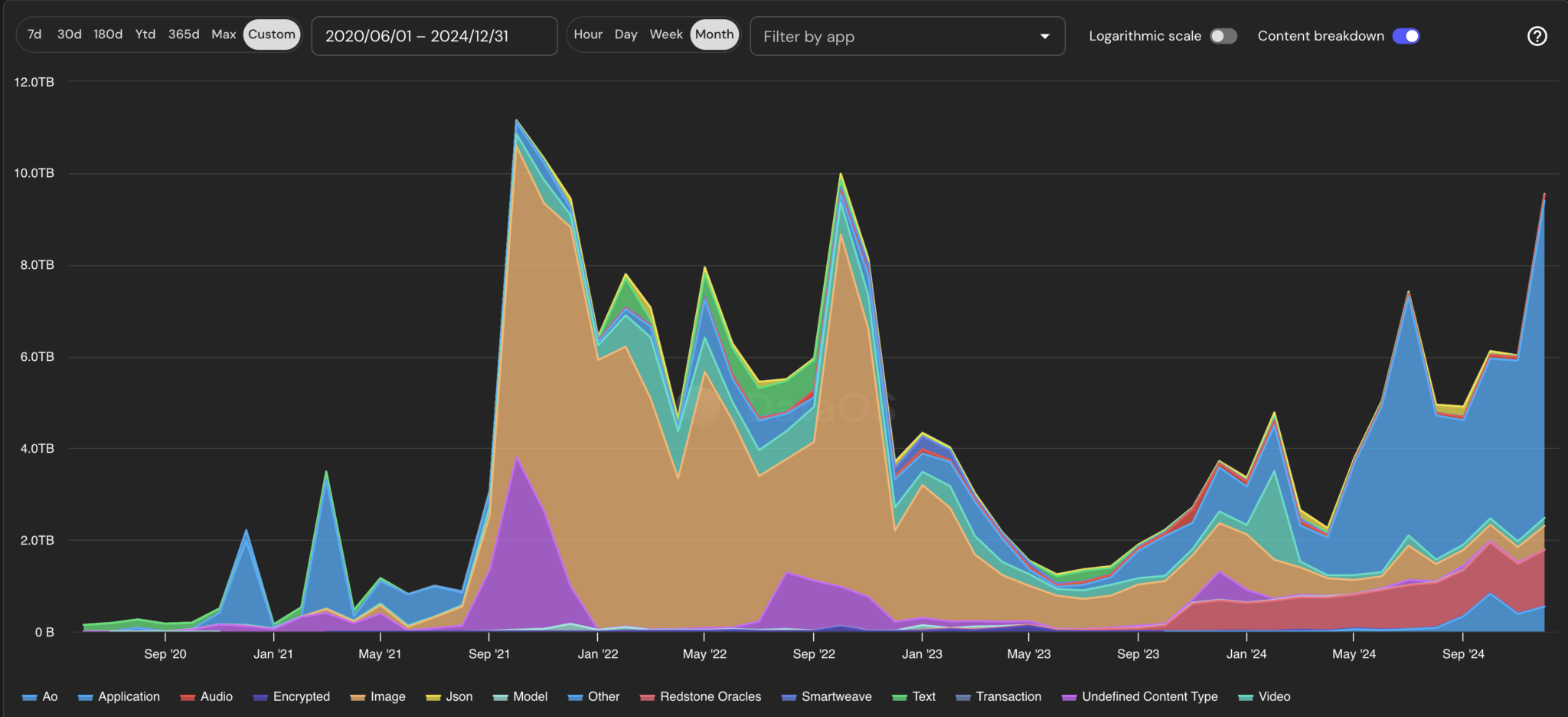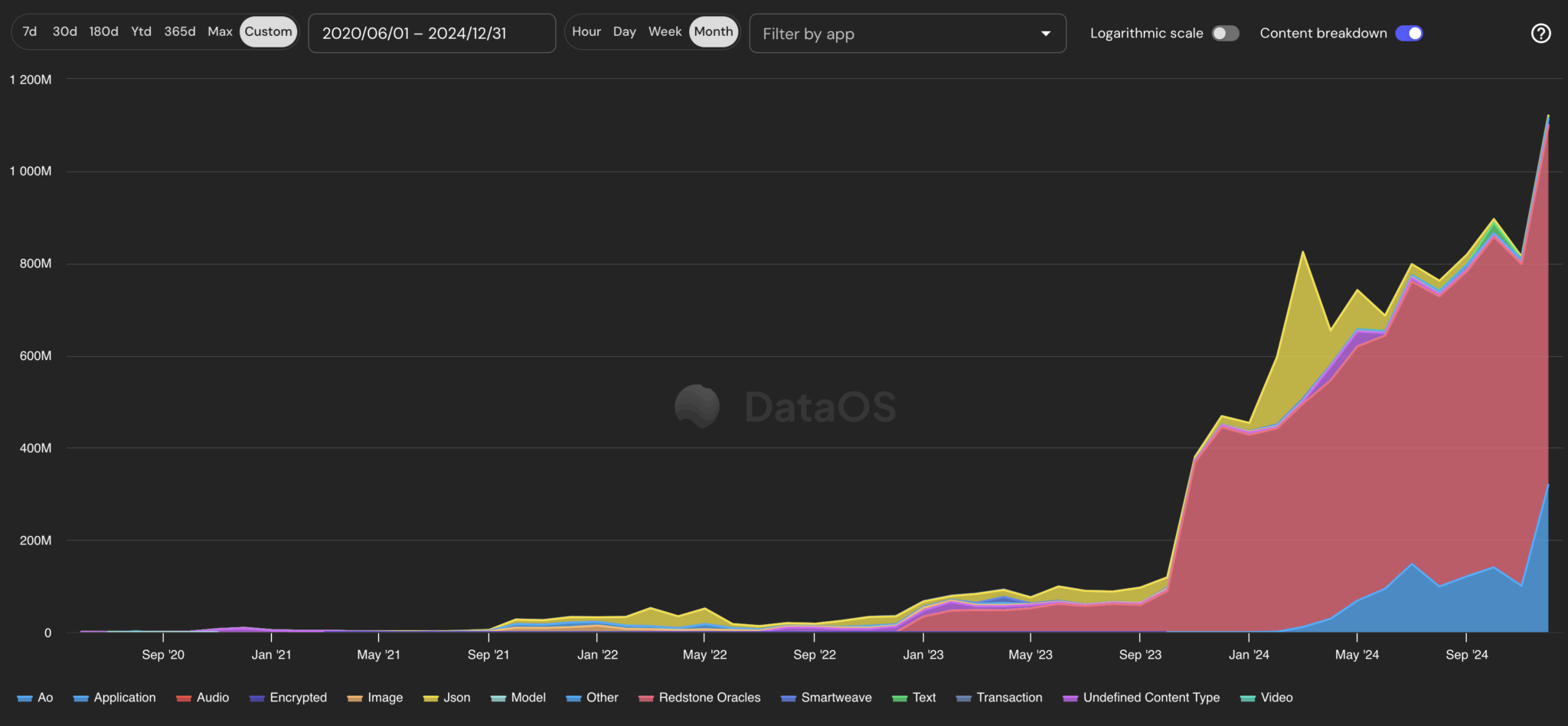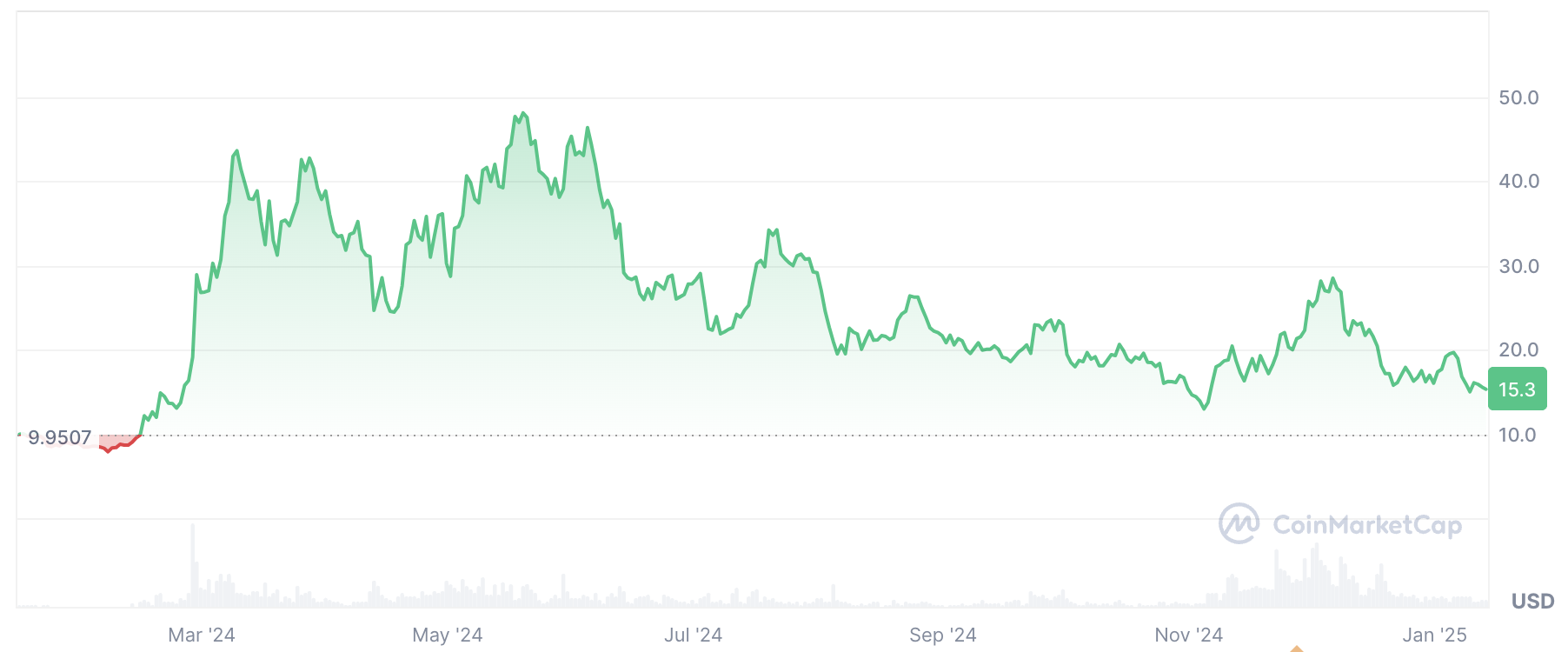
By Colton Conley
Compiled by: Kyle
Reviewer: Ayam Goreng
Source: Content Guild - Translation
Originally published on: Arrington Capital
Original link: https://www.arringtoncapital.com/blog/ao-launch-is-imminent-will-ar-get-its-mojo-back/
Brief overview of the article : AO is an upcoming AI agent coordination platform, less than a month away from the mainnet launch, which is an important milestone for Arweave and the AI x Crypto community. This article deeply analyzes Arweave's permanent data storage design, parses AO's hyper-parallel computing architecture, and explains how the two networks can drive the next wave of on-chain autonomous agents.
We outline the challenges that AR and AO will face, as well as the current market dynamics for AR tokens - revealing that a whale is liquidating AR supply from September and they are almost done selling. Finally, we also cover how to participate in the AR ecosystem and get a chance to participate in the upcoming AO.
introduction
On February 8, 2025, the AO mainnet will be officially launched - this is a major event for the AI x Crypto community and will change the way everyone interacts with on-chain agents. AO brings a hyper-parallel computing layer to the market, designed for proxy applications. This is also an important milestone for Arweave, which is the permanent data storage network behind AO, making the implementation of AO possible.
This article will break down the technology behind Arweave and AO, delve into their token economics, and explore the emerging AO ecosystem.
Important note : We were venture investors in Arweave, and as holders of AR tokens, we have also accumulated some AO tokens.
What is Arweave?
Arweave is a decentralized permanent data storage network. Users pay a one-time upfront fee based on the amount of storage required, and are guaranteed that the data will always be available. Arweave has no centralized authority management mechanism, and fees are dynamically adjusted based on miners' storage needs to ensure that miners can continue to be compensated for data storage. Arweave is a "pay once, store forever" solution. This is different from other popular data storage networks (such as Filecoin), which require users to pay ongoing fees for storage and have limited storage time.
Arweave's architecture is based on a unique design called "blockweave." While many blockchains follow a linear chain of blocks, Arweave connects each new block to the previous block and a randomly selected earlier block in the historical chain. This design forces miners to retain more historical data than standard blockchains, as they must prove that they hold the correct data fragments from recent blocks and randomly selected historical blocks to create each new block. This requirement ensures long-term permanence of the data - nodes must maintain the entire historical data set to mine new blocks and continue to receive rewards.
Arweave's token AR is used to pay fees and reward miners. When new data is published to the Arweave network and fees are paid, about 85% of the tokens will go into the Endowment for future miner reward payments. Miner rewards are calculated independently of network fees, ensuring that miners are continuously incentivized to participate in the network without being affected by user activity. This smooth mechanism for fee collection and distribution enhances confidence in Arweave's storage security.
Development momentum
Although Arweave has been running since its launch in June 2018, its real user growth began in 2021. The following chart shows the weekly data upload volume since the network was launched:

Source: https://viewblock.io/arweave/stat/dataUploaded?time=week
Data storage climbed sharply in September 2021, reached its lowest point in June 2023, and has been growing steadily since then. The following chart shows the amount of different types of data uploaded each month.
Arweave usage over time (by data size)

Source: https://stats.dataos.so/arweave
In 2021, the NFT craze swept the world, driving the first major growth in Arweave data storage. Creators began storing their JPEGs and other images on Arweave instead of linking to centralized hosting providers, which was the main reason for the surge in Arweave usage during this period. Arweave is very suitable for storing NFT artwork data because it is permanent and decentralized.
Starting in 2023, some new use cases have emerged. Among all the application scenarios, the category that uses the most storage space is applications, mainly "bundler" applications, which bundle multiple transactions and data together and publish them to the Arweave network. These applications include Bundlr (the team has changed its name to Irys.xyz and launched its own data chain in addition to the packager application). Applications that package this data, including content that would otherwise be classified as images, videos, or other blockchain data, are being permanently stored through Arweave. In addition to these bundler applications, some other projects are also taking advantage of Arweave's permanent storage capabilities. These projects include Lens' social applications, content publishing platforms, and some AI use cases.
The following chart shows activity by transaction volume. While Arweave charges fees based on the size of the data stored, use cases with increasing numbers of transactions may indicate where Arweave is headed in the future.
Arweave usage over time (by number of transactions)

Source: https://stats.dataos.so/arweave
The two fastest growing use cases by transaction volume are Redstone and AO. Redstone is one of the fastest growing oracle networks in the crypto industry, providing price data for all major assets on major EVM chains. We have made a private investment in Redstone and are optimistic about their growth prospects in expanding new partners and adding product features.
AO is a parallel computation and proxy messaging layer built on top of Arweave. We will discuss AO in detail later, but it is worth noting that AO is still in its early stages. AO is currently still running on the testnet, and the mainnet is expected to be launched in February 2025. Arweave's current growth trajectory is encouraging, and we will closely monitor whether this growth trend can continue.
The latest metrics on Arweave can be viewed via this link .
Criticism
Perhaps the most common criticism of Arweave is its low fees compared to other Layer 1 blockchains of similar size.
| network | 30-day fee | Fully Diluted Valuation (FDV) | Price/ Annual Fee |
|---|---|---|---|
| Arweave | $116k | $1.04B | 747 |
| Ethereum | $223.28m | $393.42B | 146.8 |
| Solana | $157.58m | $104.88B | 55.46 |
| Arbitrum | $2.42m | $7.31B | 251.7 |
| Avalanche | $2.27m | $25.61B | 940 |
| Polygon | $1.02m | $4.63B | 378.27 |
Source: DeFiLlama, December 2024
Looking at the metric of “price/annualized fees”, Arweave outperforms only Avalanche among all L1s. A lower ratio means that the fees paid by users are higher relative to the fully diluted market value (FDV) of the network. These data reflect the total fees generated by transactions on the blockchain - that is, the fees paid by users to transact on the blockchain. However, this does not take into account miner rewards, or in Arweave's case, contributions from the funding pool. Because Arweave distributes most of its fees to miners, its short-term profits may appear smaller than some other blockchains.
AR Token Performance
AR had a banner year in 2024. Especially after the AO announcement, the price of the Arweave token soared from less than $10 per token to over $40. The market is very excited about the potential that AO brings and the expected boost to Arweave activity. Since February 2024, AR holders have been minting AO tokens simply by holding AR in their wallets. Currently, 33% of newly minted AO tokens are being distributed to AO holders, and these tokens will become transferable after the AO mainnet goes live in February 2025. After the mainnet launch, AR holders will continue to earn a third of AO tokens until 21 million AO tokens are created. Rewards are issued every 5 minutes, and the monthly reward ratio is 1.425% of the remaining supply. This means that the issuance of tokens will gradually decrease over time.
AR Token price trend in USD:

Source: https://coinmarketcap.com/currencies/arweave/
AR prices declined during the summer as the overall market declined. However, AR lagged behind other tokens with AI value propositions such as RENDER, TAO, NEAR, etc. We believe on-chain fund flows played a role in this story.
Since September, a single whale has been selling AR tokens in significant quantities. We think we know who is selling, but this has not yet been confirmed. The wallet address dRFuVE-s6-TgmykU4Zqn246AR2PIsf3HhBhZ0t5-WXE received over 10 million AR tokens in November 2021 (total supply of AR is currently just under 66 million). There were transfers prior to 2023, and by 2024, this wallet had 5 million tokens left (worth $80 million at today's price of $16).
On September 6, 2024, the wallet transferred the remaining 5 million tokens to two addresses: i3gk39KyYCEjiylhBO9lM8DQVRtwaIG59llf2QL14Fg and jcRNRYfbIfaj_YrjN8he864KBT_4D13DL7fmj6txZgA. These two addresses subsequently sent tokens to exchanges, suggesting that these are addresses of market makers. Of the 5 million tokens, about 1.35 million are still in the hands of these (probably) market makers, ready to be transferred to exchanges.
These two addresses transferred tokens to the same two addresses on the exchange, indicating that this is likely the same market maker. This selling pressure is very large for the number of AR tokens in circulation, exceeding 7%. Once the remaining tokens are sold, the AR market may see a reduction in downward price pressure.
AO Overview
AO is a decentralized, "hyperparallelized" (super-parallel computing) network that breaks the scale and type limits of on-chain computation while keeping everything verifiable. At its core, AO is a messaging layer for independent and concurrent processes. AO leverages Arweave for permanent data logging, so any updates or interactions with a process are permanently saved. The name AO stands for "actor oriented," meaning that you can build and run modular programs (actors), each of which can choose its own virtual machine (VM), consensus method, and payment model, while still being able to communicate with other agents using standardized message formats. In practice, this means that cloud applications like Amazon EC2 can tap into AO's decentralized network and collaborate with decentralized smart contracts, all working together toward a common goal.
There are already some AO agents running in real time. One agent continuously searches for the best yield on crypto assets across multiple lending protocols, and another automatically makes fixed investments on decentralized exchanges (DEX) based on user-defined parameters. These agents utilize trusted execution environments (TEEs) to protect user privacy and allow users to hand over their private keys, which enables the agents to act completely autonomously without further instructions or commands.
An important difference between AO and other Layer 1 blockchains is that AO programs can automatically "wake up" at set times without waiting for external function calls. This makes it possible to have truly autonomous services that do not rely on centralized triggers. They can run entirely on their own schedules, and applications that rely on them do not need to rely on centralized actors to ensure survival. In the example of the yield-optimizing agent we mentioned earlier, this means that the agent can automatically wake up when you sleep and reallocate your investments to higher-yielding strategies without any prompting.
AO Architecture
Processes
Processes are like individual "agents" on AO. Each process starts from an initial state and then logs every message it receives. All of this data is stored on Arweave so it cannot be lost or censored. By separating data logging from actual computation, AO can scale to handle tasks at much larger scales than traditional blockchains.
Messages
Messages are how processes interact with users. Messages are sent across the network and have unique IDs for easy tracking. If a message is not forwarded correctly, it will not be delivered - this provides flexibility for traffic flow while still ensuring that all successfully delivered messages are permanently recorded.
Scheduler Units
Scheduling Units (SUs) attach incremental slot numbers to messages to ensure that they are uploaded to Arweave, thereby maintaining the consistency of message order. Depending on the needs of the actual application, scheduling units can be centralized or decentralized.
Compute Units
Computational Units (CUs) are responsible for performing the actual computational tasks. They are free to choose which processes to execute, forming a competitive market for computational services. After completing their work, the CU returns a signed proof of the process state change - as well as any new messages or new processes triggered by that state update.
Messenger Units
Message passing units (MUs) are responsible for passing messages across the network. They first send each message to the scheduling unit, ensure that the message is recorded on Arweave, and then forward the message to the computational unit. If a process generates more messages in response, the message passing unit will continue to forward these messages until all operations are completed.
Challenges facing AO
AO is not without its challenges. Each network ultimately defines itself by excelling in certain areas. For example, Arbitrum has emerged in the DeFi space, Solana focuses on memecoins and DePin, and IMX focuses on gaming. But Arweave has always focused on content storage, blockchain archiving, and persistence of oracle data. While AO aims to redefine decentralized content storage and DeFi, it still faces many challenges, especially in promoting the application of AI agents in DeFi.
The use of AI agents in DeFi has been slower to develop elsewhere . We have yet to see a breakthrough application that effectively incorporates AI into the DeFi space. The closest example so far is the introduction of machine learning models on-chain to optimize the returns of funding pools. However, these machine learning models tend to be very simple algorithms that are mainly used to predict returns and compare them to the transaction costs of switching strategies. These models are simple and linear, which helps reduce overfitting and "hallucination" phenomena. In contrast, models like large language models (LLMs) are highly non-linear, non-deterministic, and often have difficulties with basic calculations such as number crunching. It may be some time before we see true AI agents managing our funds, rather than just user-defined intentions wrapped in agent form.
Arweave is not historically a DeFi chain . While there have been some attempts to build decentralized exchanges (DEX) on Arweave, none have managed to achieve breakout growth. This is not surprising given that Arweave was originally intended to store content such as images. It will be interesting to watch AO’s future developments as it attempts to attract Arweave’s existing community and users, as well as new users on other chains. The team has clearly considered this challenge, which is reflected in AO’s token economics. Participants who transfer DAI and stETH to the AO network will be rewarded with AO tokens, in addition to being able to earn yield using these bridged tokens in the AO mainnet. To date, AO has attracted about $578 million in TVL (total value locked). It will be critical to keep this portion of funds and interact with emerging DeFi applications.
Airdrop Mechanism
Token Supply : A total of 21 million AO tokens, which will be halved at predetermined intervals.
AO token minting qualifications:
- AR token holders will receive AO tokens based on their AR balance.
- Users who bridge DAI and stETH will also receive token allocations.
Distribution method :
- 1.03 million AO tokens will be distributed retroactively to holders and bridgers since February 27, 2024. All AO tokens minted during this period have been distributed to AR token holders based on the corresponding balance held every 5 minutes.
How to participate
If you’ve read this far, you might be interested in participating in the AO ecosystem. Here are some of the best ways to get started:
- Holding AR Tokens : Since one-third of new AO tokens will be distributed to AR holders, simply holding AR tokens is a great way to gain exposure to AO tokens.
- Bridge DAI or stETH : Currently, two-thirds of AO tokens will be distributed to users who bridge DAI or stETH to AO. This is also a good way to earn AO tokens without taking the risk of AR price fluctuations.
- Using AO Mainnet Applications : The AO Mainnet will be launched in February, and multiple trading and lending platforms will be available. You can check out the AO ecosystem to learn more.
- Providing computing resources : Anyone can provide computing resources for various processes in the AO network without permission. For people with a strong technical background, this may be one of the best ways to understand the AO ecosystem and directly participate in it.
Future Outlook/Summary
The AO mainnet will be launched in February 2025, when anyone can provide computing resources or set up their own processes and agents. The token bridge function will also be open, allowing any token to enter the AO network. As more people join and build advanced AI or automated services, AO's decentralized and massively parallel architecture will unlock a range of new possibilities - especially in areas that require trustlessness and efficient computing.
The launch of the AO mainnet will be a major milestone for the Arweave and AI x Crypto communities. We will be watching this ecosystem closely.















